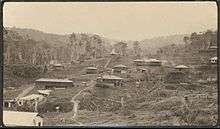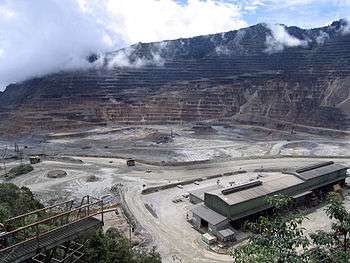Mining in Papua New Guinea

Mining in Papua New Guinea is an important source for the Papua New Guinea economy.
History
Up until 1970, there was little mineral extraction in Papua New Guinea, but since the 1970s mineral extraction has dominated the national economy.[1]
With the exception of the Ok Tedi Mine (copper-gold) almost all of the mining in PNG has been gold mining. The two largest gold mines are the Porgera (Enga Province) and Lihir (New Ireland Province) mines. In 2009, the Hidden Valley gold and silver mine (Morobe Province) commenced production. 2010 will see the start of production from the Ramu nickel-cobalt mine.
All the mining activity that has taken place in the country since 1970 has produced approximately 5 million tonnes of copper between 1970 and 2007. The country produced 202,277 t of copper in 2003 compared to 211,315 in 2002, all of which was produced by the Ok Tedi Mine the most active mine in the country. The mine reported that 29.32 Mt of ore was mined (approximately 240,000 t/d material moved) and 29.26 Mt milled (77,000 t/d) with a head grade of 0.78% Cu and 0.8 g/t Au. Respective gold and copper recoveries for 2003 at Ok Tedi were 68% and 84%.
Mines
Edie Creek

Edie Creek has been a historic gold and silver mining area since 1926.[2] Located about 5 km south-west of Wau, it was the centre of one of the first major gold rushes in PNG before World War II.[2] Large amounts of gold have been extracted by both alluvial and underground mining.[2]
Hidden Valley/Hamata
Hidden Valley is an open-pit, gold-silver mine and processing plant in Morobe Province.[3] The mine is approximately 210 km north-north-west of Port Moresby, and 90 km south-southwest of Lae.[3] It is operated by Morobe Mining Joint Ventures, a 50:50 joint venture between Harmony, a company that operates primarily in South Africa, and Newcrest Mining, an Australian gold and copper mining company.[3] The metals are epithermal deposits from hydrothermal systems related to volcanic activity.[4]
Lihir
Lihir is an open cut gold mine operating on the Island of Lihir in PNG. It is wholly owned by Newcrest Mining.
Mt. Kare

Ok Tedi Mine
The Ok Tedi Mine is situated at Mount Fubilan in the Star Mountains in western PNG, close to the Indonesian border. OK Tedi Mining Ltd. (OTML) is 100% Government owned (2014).
Panguna mine
Bougainville Copper Limited (BCL) developed the Panguna mine, producing copper concentrate from 1972 until May 1989, when mining operations were suspended due to civil unrest in the province.[5] Rio Tinto is a major shareholder of the BCL (54%) and is currently reviewing its stake in the company. The deposit has a life of mine of some 20 years and has a capacity to produce 180 000t of copper and 480 000 oz gold per year. This development marked one of the first major investments in PNG, and was at one stage one of the world's largest copper - gold mines.
As of 2014, talks of restarting mining operations in Panguna mine have continued, with BCL seeking official endorsement from the Autonomous Bougainville Government and the National Government of Papua New Guinea.[6]
Porgera
The Porgera Gold Mine is a large gold mining operation located in Enga province. The mine is located at the head of the Porgera Valley and is operated by Barrick Gold d.b.a. Porgera Joint Venture (PJV).
Ramu
According to the project proponent Ramu NiCo "Ramu Nickel project is located in the Madang Province of Papua New Guinea. The annual output will be nickel/cobalt intermediate product, in which the aggregate nickel metal accounts for 31,000 tonnes and cobalt 3,000 tonnes.
The Project is composed of three parts: the Kurumbukari mine site, the Basamuk processing plant and a 135 kilometers slurry pipeline from the mine to the processing plant. The mine is located on the Kurumbukari plateau, on the southern side of the Ramu River Valley, 75 kilometers to the southwest of Madang. The processing plant site is located on coast of Basamuk bay, 55km to the southeast of Madang.
First discovered in the 1960s, the kurumbakari mine site was once explored intermittently by several companies. By the 1990s, Highlands Pacific Limited completed detailed exploration followed by a feasibility study. In 2005, China Metallurgical Group Corporation (“MCC”) acquired the majority interest in the Project and Ramu NiCo Management (MCC) Limited became Manager and Operator for the Ramu Nickel Joint Venture. The Project construction has now been substantially finalized and is being progressively commissioned."
Simberi Oxide Gold Project
Allied Gold, an Australian-based company, operate an open pit gold (and silver) mine called the Simberi Oxide Gold Project in the volcanic highlands on the eastern side of Simberi Island[7] Gold production started in February 2008 and the mine has a projected life of 8 years.[7] Production for the 2008 calendar year was 75,267 ounces (2,133,787 grams).[7]
Solwara 1
3°47′20″S 152°05′38″E / 3.789°S 152.094°E[8]
The Solwara 1 Project is located at 1600 metres water depth in the Bismarck Sea, New Ireland Province.[9] It will be the world’s first deep-sea mining project, with first production expected in 2013.[9][10] The resource is high grade copper-gold resource and the world's first Seafloor Massive Sulphide (SMS) resource.[9] In 2014 a 20-year mining license was granted to a Canadian company.[11]
References
- ↑ "Papua New Guinea". Retrieved February 1, 2010.
- 1 2 3 "Exploration & Mining Bulletin Quarterly Bulletin" (PDF). Mineral Resources Authority (MRA) of Papua New Guinea. March 2008. Retrieved 11 January 2011.
- 1 2 3 "Hidden Valley". Harmony Gold Mining Company Limited. 2010. Retrieved 10 September 2010.
- ↑ "Harmony Annual Report 2010" (PDF). Harmony Gold Mining Company Limited. 2010. p. 155. Retrieved 12 November 2010.
- ↑ "About the Company". Retrieved 24 August 2015.
- ↑ "Bougainville Copper Limited". Retrieved 24 August 2015.
- 1 2 3 "Simberi". Mineral Policy Institute. Retrieved 9 September 2010.
- ↑ Lipton, Ian (2008-02-01). "Mineral Resource Estimate, Solwara 1 Project, Bismarck Sea, Papua New Guinea for Nautilus Minerals Inc" (PDF). Golder Associates Pty Ltd. Retrieved 14 September 2010.
- 1 2 3 "Solwara 1 Project – High Grade Copper and Gold". Nautilus Minerals Inc. 2010. Retrieved 14 September 2010.
- ↑ Hill, Matthew (2010-09-07). "Nautilus says could start undersea mining in 2013". Mining Weekly. Retrieved 14 September 2010.
- ↑ Kaknevicius, Ariana (13 May 2014). "Canadian mining company could be involved in world's first deep sea mine". Canadian Geographic. Retrieved 24 March 2015.
External links
- PNG Chamber of Mines and Petroleum
- Mineral Resources Authority (MRA) of Papua New Guinea
- Map of mining projects 2010
- Mining Journal special publication – Papua New Guinea (November 2009)
- The regulation of exploration and extraction in 31 jurisdictions worldwide - Papua New Guinea (2010). Law Business Research Ltd
- Photo Gallery: Mining in Papua New Guinea 1983-2010
- Mining in Papua New Guinea - InfoMine
- PNG Mining News & Information
- Press review: Mining in the South Pacific (since May 2009)
